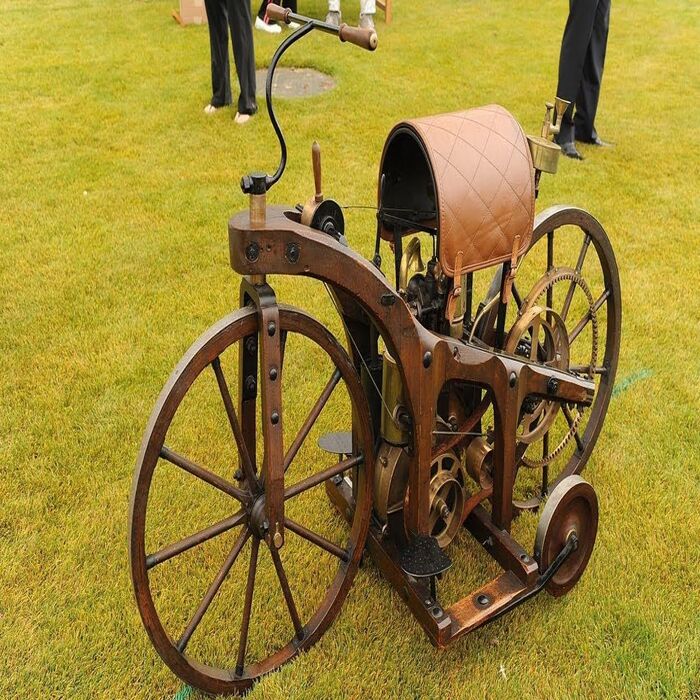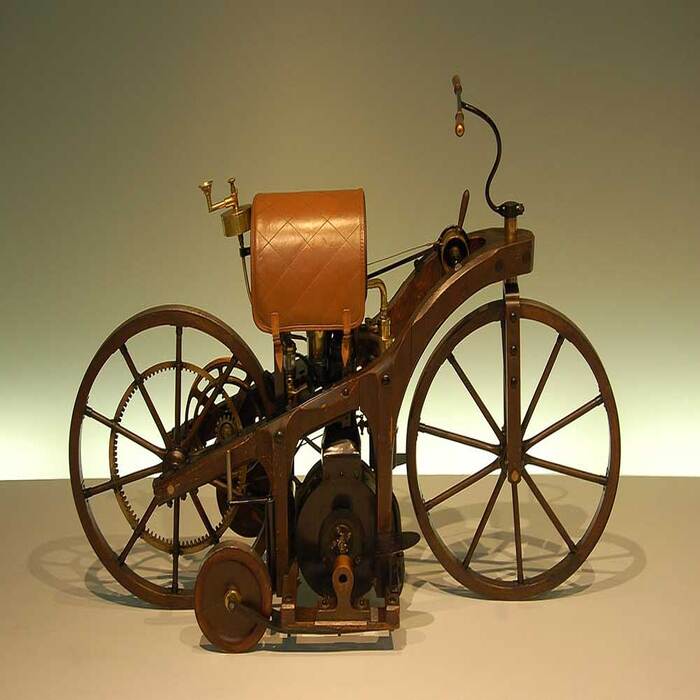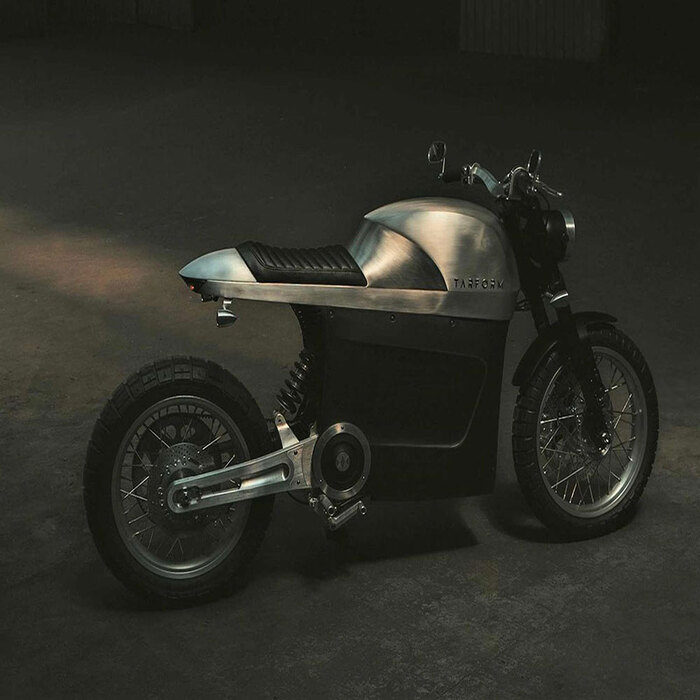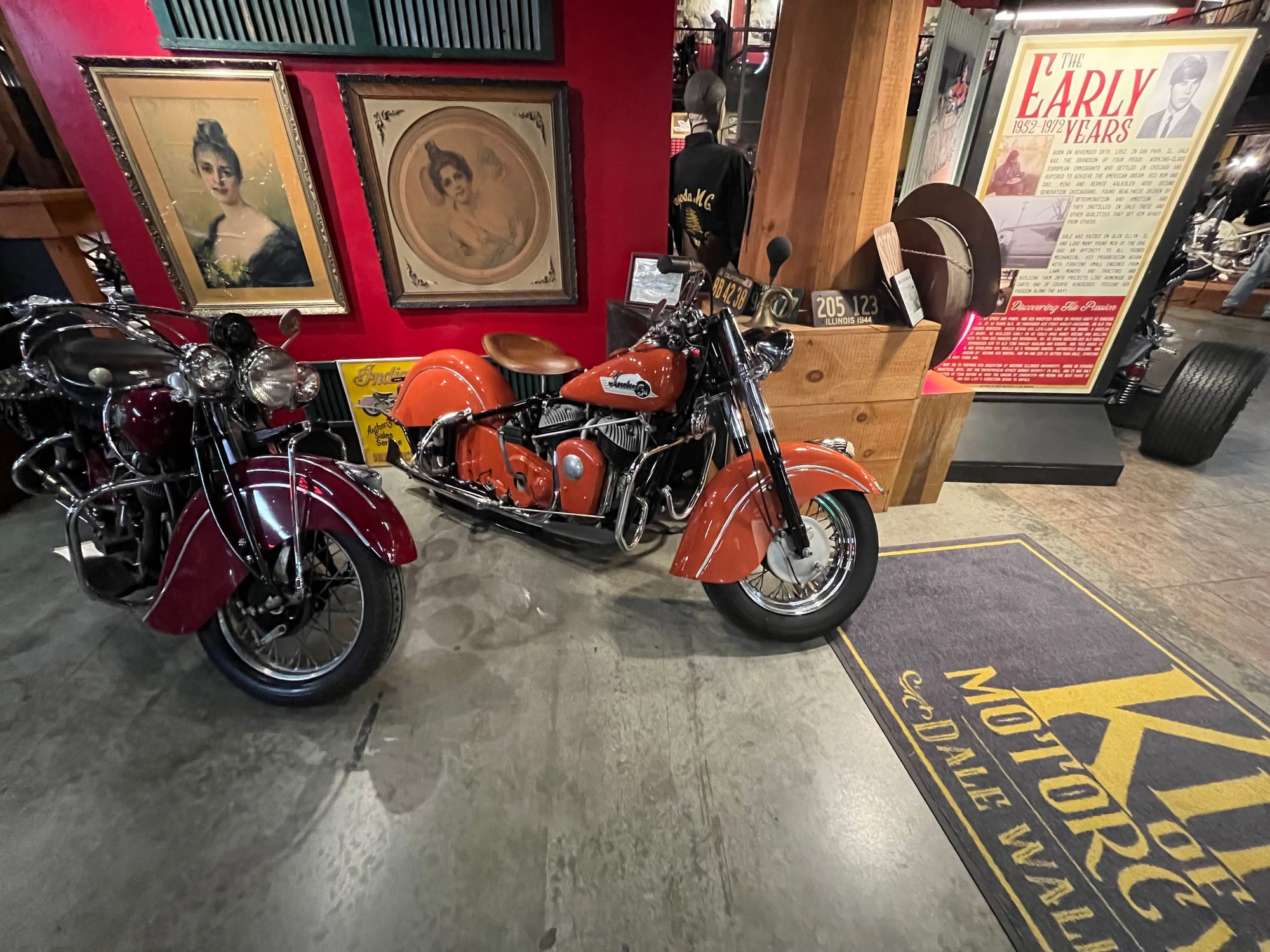The Spark of Two-Wheeled Innovation
Who invented the motorcycle? The journey to the first motorcycle began amidst the smoke and clamor of the Industrial Revolution. Emerging from this era of discovery, bicycles received a transformative boost. The idea of self-propelled two-wheeled transport took hold, igniting imaginations and engineering prowess. This period saw numerous inventors vying to usher in a new age of mobility. Groundbreaking trials with steam power and rudimentary engines paved the way towards motorization
Within this hotbed of invention, early motorcycle prototypes emerged. They blurred the line between bicycles and motorized vehicles. Simple at first, but with dreams of combining speed, agility, and the thrill of the ride, these prototypes were the kernels from which the modern motorcycle would grow. The invention of the internal combustion engine, especially the four-stroke engine by Nikolaus Otto, was a crucial leap forward. It promised reliable, efficient propulsion, something visionaries had sought for decades.
Soon, the unique spirit of motorcycles began to crystallize around the concept of freedom and exploration. This emergent form of transportation held the promise of unfettered travel, the wind as a constant companion. This revolution brought together talents like Gottlieb Daimler and Wilhelm Maybach, whose collaboration would leave an indelible mark on history.
With every trial and error, every spark in the cylinders, the archetype of the modern motorcycle took shape. It became a symbol of innovation, resilience, and a ceaseless quest for progress. This is the story of two-wheeled innovation, a tale of how the motorcycle became more than a means of transport; it became a path to new horizons.

Deciphering the Origins: The Daimler Reitwagen Debate
When exploring who invented the motorcycle, debate often centers on the Daimler Reitwagen. The Reitwagen, built in 1885 by German inventors Gottlieb Daimler and Wilhelm Maybach, is frequently cited as the first motorcycle. Yet, some historians argue that this machine was more of a motorized carriage due to its stabilizing wheels. This raises questions about the Reitwagen’s classification as a true motorcycle.
The invention of the Reitwagen is a pivotal moment in motorcycle history. However, its unique design, with both large and small wheels, challenges typical definitions. Many enthusiasts argue that a true motorcycle requires balancing and leaning capabilities, absent in the Reitwagen. This debate does not diminish its importance. The Reitwagen represents a significant step towards motorized two-wheeled vehicles.
Despite its controversy, the Reitwagen played a key role in propelling the development of the motorcycle. It showcased a gasoline-powered engine on a two-wheeled frame, opening doors to future innovation. Acknowledging its limitations and contributions provides a clearer picture of the motorcycle’s origins. As we delve deeper into the rich tapestry of motorcycle history, the Reitwagen remains a landmark innovation. Its legacy continues to shape the two-wheeled technologies of today and tomorrow.
Defining Moments: Key Technological Advancements
The path to the modern motorcycle saw critical breakthroughs, each marking a defining moment in its evolution. Central to these was the integration of the internal combustion engine. Pioneered by Nikolaus Otto with his four-stroke engine in 1876, it offered efficient propulsion, vital for early motorcycles. Gottlieb Daimler’s application of this engine in the Reitwagen in 1885 was another leap forward. This invention demonstrated the engine’s potential on two wheels.
Advancements in frame design also propelled the motorcycle forward. Early motorcycles had wooden frames, modeled on bicycles. Daimler’s Reitwagen, for instance, had a wooden frame, similar to a riding car. This concept would later evolve into more durable materials, enhancing performance and safety.
The innovation of carburetors improved fuel-air mix, optimizing engine performance. The Reitwagen employed a spray-type carburetor, a significant advance at that time. Handlebars for steering, iron-tread wheels for better traction, and the omission of pedals underscored the shift towards full mechanization.
Pneumatic tires were a game-changer, introduced by John Dunlop in the late 1800s. They transformed the motorcycle’s handling, enabling higher speeds and more agile cornering. Without pneumatic tires, motorcycles lacked the crucial ability to maneuver effectively and safely.
It’s clear that the motorcycle’s journey was marked by key technological advancements, each contributing to the creation of the powerful, efficient, and versatile machines we know today. With these innovations, motorcycles became more than just a novel idea; they became a practical and exciting mode of transportation.
Contributions of Gottlieb Daimler and Wilhelm Maybach
The pair known as Daimler and Maybach made lasting impacts on two-wheeled history. They worked together to create the Reitwagen, the machine many consider the first motorcycle. Daimler brought visionary ideas and engineering skill to the team. Maybach contributed with his knack for refining technical designs. They aimed for more than a faster bike; they sought a new way to ride.
Their Reitwagen broke new ground with its gasoline engine. This engine marked the departure from human and steam power. They also designed a spray-type carburetor. This device improved how engines burned fuel, giving riders more power. Besides the engine, they crafted solid wooden frames to support the machinery. They fitted the bike with iron-tread wheels, another bold move.
Their teamwork led to the foundation of the Daimler-Motoren-Gesellschaft (DMG) in 1890. Under this company, they kept pushing the limits of what vehicles could do. They created more ground-breaking cars, leading to the motorcycles we see today. Their work sparked ideas and inspired builders all around the world. Their legacy lives on in the pursuit of innovation and performance in motorcycling.

The Reitwagen: A Closer Look at the First Motorcycle Design
Taking a closer look at the Reitwagen reveals much about early motorcycle design. This vehicle, created by Gottlieb Daimler and Wilhelm Maybach in 1885, stirs debate about what qualifies as a motorcycle. Its features were unlike those of later motorcycles, yet it remains a critical piece of two-wheeled history. The Reitwagen had a frame made of wood, resembling a carriage or a bicycle, showing the transition from pedal power to engine power. The single-cylinder Otto-cycle engine was its heart, a leap in technology at the time. Its spray-type carburetor mixed fuel and air efficiently, enhancing performance. The Reitwagen ran on iron-tread wheels, offering a sturdy ride before the days of rubber tires. Two outrigger wheels provided stability, which has led some to question its true motorcycle status. However, it lacked pedals, distancing it from the bicycle family and inching closer to motorization. Despite its unusual design, the Reitwagen’s contributions were pivotal, bringing us closer to the motorcycles we recognize today.
Rival Claims and Contenders for the Title
The debate on who invented the motorcycle is far from settled. Different inventors around the world have laid claim to this title, each with their own unique contributions to the development of motorized two-wheel vehicles. Let’s take a look at some key rival claims and contenders:
- The Michaux-Perreaux Steam Velocipede of the 1860s offered an early example of a self-propelled two-wheeler. It used steam power, predating combustion engines.
- Sylvester H. Roper also experimented with steam power and built his steam velocipede in the United States during the 1860s.
- ?tienne Lenoir put a commercial engine on a tricycle in the 1860s, but this differed from the two-wheeled ideal.
- The Millet motorcycle, fitted with pneumatic tires in 1892 by Félix Théodore Millet, brought handling into the equation. This is essential to motorcycles as we understand them today.
- Karl von Drais deserves mention for his ‘Swiftwalker’ or ‘Draisine’ of 1817. While it was pedal-less and not motorized, it set the stage for bicycle development which influenced motorcycles.
- John Dunlop’s invention of pneumatic tires in the late 1800s was also critical. These tires were vital for the handling of later motorcycles.
This array of innovators from different parts of the world demonstrates that the true roots of the motorcycle lie in a collective effort. The invention we celebrate today is not the work of one individual but the culmination of many ideas, experiments and incremental advancements from around the globe. This rich history underpins the diverse, innovative world of motorcycles that captivates enthusiasts to this very day.

The Role of Pneumatic Tires in Motorcycle Evolution
The journey to the motorcycle we know today involved many innovations. One key advancement was the introduction of pneumatic tires. These tires, filled with air, were a huge leap for motorcycle handling and comfort. Let’s break down their impact:
- Improved Traction: Pneumatic tires offered better grip on roads. This made riding safer and allowed for higher speeds.
- Enhanced Comfort: These tires absorbed shocks from uneven roads much better than solid wheels. Riders could enjoy longer trips with less discomfort.
- Agile Handling: Motorcycles could now lean into turns with ease. Pneumatic tires supported this newfound agility in cornering.
- Wider Adoption: With improved ride quality, more people began to see motorcycles as viable transport.
Scottish inventor John Dunlop first developed pneumatic tires in the 1880s. Although initially for bicycles, their benefits for motorcycles were undeniable. By the 1890s, manufacturers began fitting motorcycles with these tires. This change marked a major step in motorcycle evolution.
Motorcycles shifted from rigid, cumbersome machines to nimble and dynamic rides. As the engines became more powerful, pneumatic tires became essential. They supported faster speeds and better control. This evolution sparked the imagination of riders and inventors alike.
In short, pneumatic tires played a critical role in the transition from early motorized bicycles to modern motorcycles. They gave riders the confidence to push boundaries and explore further. The motorcycle’s role in personal freedom owes much to this simple yet revolutionary invention.
The Collective Effort: Global Contributions to Motorcycle Development
The making of the motorcycle was a worldwide effort. Many minds from across the globe played a part. They tinkered, innovated, and shared ideas that brought us today’s motorcycle. We cannot name just one inventor of the motorcycle. Instead, we see a rich history of collective innovation.
In Europe, steam power pushed early bikes forward. In America, inventors added engines to bicycles. Each advance brought us closer to the motorcycles we know. It was a mix of creativity and persistence that fueled this journey.
Teams like Daimler and Maybach in Germany made critical leaps. Their Reitwagen introduced the gasoline engine. Yet, the Reitwagen’s true place in motorcycle history is complex. It sparked ideas but didn’t define the whole story.
Other inventors made their mark too. Steam velocipedes and early three-wheelers played a role. So did the pneumatic tire, first made for bicycles. This invention alone changed how motorcycles rode and felt.
The first motorcycle was not just a single creation. It was the sum of many parts. Each small step by various inventors was key. Together, they crafted a machine that would change mobility forever. They gave us speed, freedom, and the thrill of the open road.
In this way, the history of the motorcycle mirrors our collective human spirit. It shows our desire to connect, share, and build on each other’s ideas. The motorcycle is a product of this shared passion and vision. It is a testament to what we can achieve when we work together toward a single dream.



